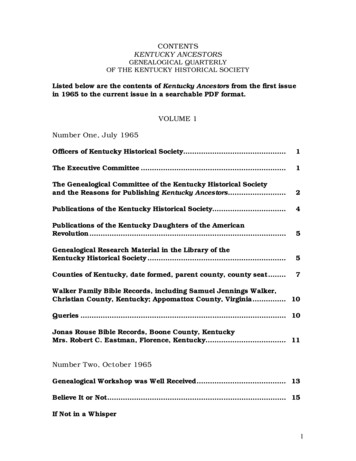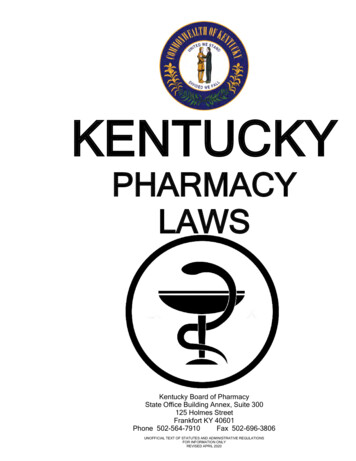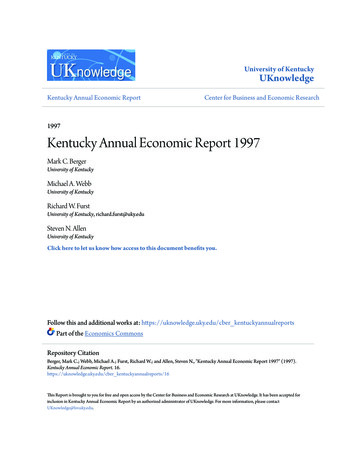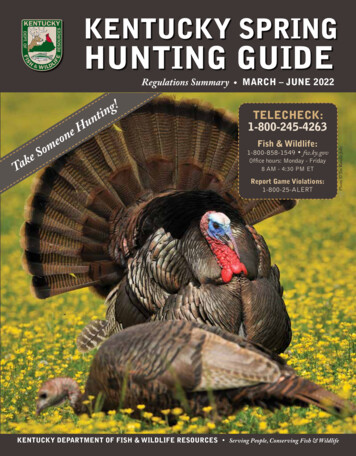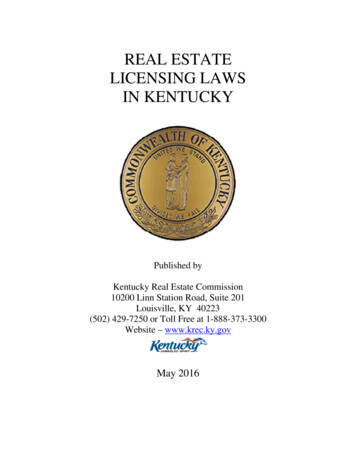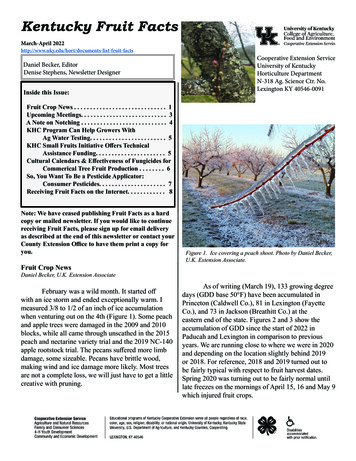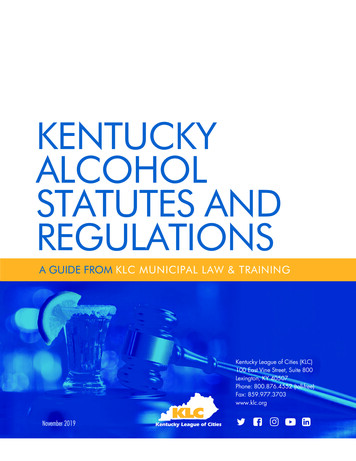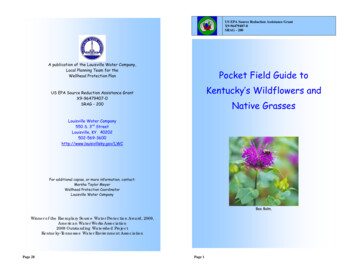
Transcription
US EPA Source Reduction Assistance GrantX9-96479407-0SRAG - 200A publication of the Louisville Water Company,Local Planning Team for theWellhead Protection PlanPocket Field Guide toKentucky’s Wildflowers andUS EPA Source Reduction Assistance GrantX9-96479407-0SRAG - 200Native GrassesLouisville Water Company550 S. 3rd StreetLouisville, KY r additional copies, or more information, contact:Marsha Taylor MeyerWellhead Protection CoordinatorLouisville Water CompanyBee Balm,Winner of the Exemplary Source Water Protection Award, 2009,American Water Works Association2009 Outstanding Watershed ProjectKentucky-Tennessee Water Environment AssociationPage 28Page 1
What is a wildflower?Native wildflowers are defined as being herbaceous floweringplants, excluding sedges and grasses. A native species is one thatwas growing in Kentucky prior to European settlement and hasadapted to certain habitats in response to specific climatic,geologic, and topographic variables.In order to make it easier for the amateur to identify and selectplants for garden planning purposes, only the showy wildflowerswere selected to be in this guide. In addition, to further narrowthe list, (as this guide is not intended to be used as a referencebook for professionals), the wildflowers selected were listed byvarious nurseries as readily available live plants in the Louisville,Kentucky area. By selecting native plants that flourish in theLouisville/Jefferson County area, native plants that do not thrivein this environment were omitted.Many wildflowers have the word “weed” as a part of their name,but are not considered to be a pest to the wildflower/wildlifeenthusiast. For example, ironweed, a very showy, nativewildflower is considered a weed by agriculturalists, becauselivestock will not eat it, and the plant may become invasive inplowed or otherwise disturbed fields. However, for thewildflower/wildlife enthusiast, the plant is showy, fairly easy tocultivate, and therefore a desirable wildflower.Conserving wildflowersCollecting wildflowers from theirnative habitat is harmful byeliminating plants from theirnatural habitat, where thepopulation falls below the minimumrequired to sustain the plant.With the introduction of nonnative species, which are lessedible, wild animals eat or tramplethe wildflowers until the populationis diminished to where it can notcontinue to survive in its naturalPage 2Frank’s SedgeFringed SedgeCarex frankiiCarex crinitaHop-like SedgeCarex lupuliformisAttraction –Butterfly, MothComment:2’-2.5’, WildlifeAttraction –Butterfly, MothComment:2’-5’, WildlifeAttraction –Butterfly, MothComment:2’-3’, WildlifeSallow SedgeSideoats GammaSoft or Common RushCarex luridaBouteloua curtipendulaJuncus effususAttraction –Butterfly, MothComment:2’-5’, WildlifeAttraction –Butterfly, MothComment:1’-1.5’, WildlifeAttraction –Butterfly, MothComment:1’-1.5’, WildlifeLouisville Water Company550 S. 3rd StreetLouisville, KY 40202The Ginseng plant has become veryrare in Eastern Kentucky due toover collecting and replacement byinvasive non-native plants that areless nutritious for wildlife.SwitchgrassVirginia Wild RyePanicum VirgatumElymus virginicusAttraction –Butterfly, MothComment:3’-5’, WildlifeAttraction –Butterfly, MothComment:2’-4’, WildlifePage 27For more information,please visit our web site:http://www.louisvilleky.gov/LWC/ch water quality/under Wellhead Protection
habitat. This also increases the likelihood that the area will beinvaded by a non-native plant.Dark Green BulrushScirpus atrovirensAttraction – Butterfly, MothComment: 3’-5’, WildlifeEastern GammaGrassGiant Plume GrassTripsacum dactyloidesAttraction -- Butterfly, MothComment:10 Attraction -- Butterfly, MothComment:6’-8’, WildlifeSaccharum giganteumIn addition, there is no assurance that moving a plant from itsnatural environment will enable it to survive in other areas. Forexample, most orchids have a special relationship with fungi in thesoil. When these plants are dug up and removed from their nativesoil, and transplanted into a different soil, the fungi does notexist that enable the plant to survive. Other plants may haveexacting soil, acidic, basic, or other requirements that a differentarea may not meet. For example, azaleas and nativerhododendrons require a sandy, well-drained, acid soil. Theseplants will not live in the limestone regions unless the soilenvironment is modified to meet their needs.Lastly, by adding wildflowers or other plants collected from thewild to your yard, you can bring in diseases, fungi, and otherpathogens that could harm other plants in your landscape.Indian Grass,WoolgrassSorghastrum nutansAttraction -- Butterfly, MothComment: 5’-6’, WildlifeJune GrassMelic GrassKoeleria cristataMelica nitensAttraction -- Butterfly, MothComment:2’ , WildlifeAttraction -- Butterfly, MothComment:2’ , WildlifePurchase native plants from a reputablenursery or greenhouse that grows theirown plants from seed. Or, you may orderthe seed and grow the plants from seedyourself. Either way, you can make surethat the native plant you wish to use hasnot been improperly collected, and will notadd unwanted elements to your yard.There are many nurseriesin Kentucky that specializein native plants.TaxonomyFor the amateur, taxonomy of plants can be a nightmare ofunfamiliar Latin names that almost, but not quite, make sense.Taxonomically, plants are named according to genus and species,with specific variations within the species defined. For theamateur, determining the correct taxonomic classification can beconfusing and frustrating.Prairie DropseedRiver OatsFox SedgeSporobolus heterolepsisChasmanthium latifoliumCarex vulpinoideaAttraction -- Butterfly, MothComment: 2’-3’, WildlifeAttraction -- Butterfly, MothComment: 2’-3’, WildlifeAttraction -- Butterfly, MothComment: 2’-3’, WildlifePage 26In general, common names vary from region to region and are notaccurate. For this reason, it is always wise to order plants and/orseeds by their taxonomic name, i.e. the genus and species.Many guides are available that show garden designs, with thevarious plants used in the design listed by genus and species.Page 3
When comparing the genus and species of the plants used in thepre-designed gardens, it is likely that the plants listed will not bereadily available to someone living outside the particular regionfor which the garden was designed.However, in designing your own garden, you can use the designpresented, and research the taxonomic classification and theplant’s particular characteristics, substituting plants available inyour region that have the same genus, if not the same species. Besure to note the characteristics of the plants you are using assubstitutes, so that they more closely match the original design.You can always ask your local Cooperative Extension Agent oruniversity for more help.rain gardens, or in dramatic groupings, are the native grassesfound in Kentucky. These plants are being crowded out by manyinvasive plants or grasses, or are being eaten by the wildlife toendangerment because these plants are more nutritious and fillingthan the invasive species.Many of the grasses are used in native meadow or prairie seedmixes, but may also be used as decorative plots in thehomeowner’s lawn, or as single plants or groupings to add varietyto a native plant garden. There are many nurseries specializing innative wildflowers or plants, while others may be ordered in bulkin meadow mixes. Most of the grasses are also native to otherstates.Sources of InformationA variety of sources were used todetermine the types of nativeflowering plants to list in thisselection, to confirm plantcharacteristics, and to checktaxonomic classification. First, toselect the plants to be spotlighted,the listings from several “local”companies, (as well as state andlocal agencies), of native plantsavailable for sale as live plantswere used. This provided a basefor the general guide.Daisy Fleabane, a common KYwildflower. Photo by Ken Thomas.There are many companies in Kentucky that sell native plants tothe general public, as live plants or as seed. Some of thecompanies will deliver live plants, or the customer may visit thegreen house and choose live plants from the nursery for use innative plant gardens. Other areas of the state and other statesalso have companies that specialize in the sale of native plants,either as seeds or live plants, which specialize in plants for thatparticular region. The plants listed here are readily available aslive plants to the population of Louisville, Kentucky and thePage 4BeakgrassBearded ShorthuskDiarrhena americanaBrachyelytrum erectumBlue Wood SedgeCarex flaccospermaAttraction – Butterfly, MothComment: 1’ – 2’, WildlifeAttraction -- Butterfly, MothAttraction – Butterfly, MothComment: .5-.9’, WildlifeBottlebrush GrassBig BluestemSplitbeard BluestemAndropogon gerardiAdropogon ternariusElymys hystrixAttraction – Butterfly, MothComment: 3’-6’, WildlifeAttraction -- Butterfly, MothComment: WildlifeAttraction – Butterfly, MothComment: 2’-4’, WildlifePage 25
Kentucky Bluegrass, Bermuda Grass, Orchard Grass, RedtopGrass, and Timothy Grass). Native ragweed is one native plantwhich is highly allergic.Will Native Plants Attract Pests?Unsecured garbage is the mainattraction for most pests, such asrodents and raccoons. Nativelandscaping is not. Native plants willattract butterflies and dragonflies,birds, bats, frogs and salamanders, aswell as insects that provide shelterand food for the wildlife. In return,the wildlife will help control peskybugs such as mosquitoes. CanadaGeese, considered to be a pest insome areas, prefer short turf grassto taller native grasses.surrounding area. They may also be available in other states, orother regions of Kentucky.This pocket guide is designed to help the homeowner select nativeplants for use in a home garden, and is not a guide for otherprofessionals.Pocket Guide to Some Common Kentucky WildflowersAmerican AloeAlumroot, Coral BellsAgave virginicaHeuchera AmericanaAnemone, Rue AnemoneAnemone thalictroidesComment: Repels wildlifeKentucky’s Native GrassesAlthough it may be hard to imagine, Kentucky was once covered byabout 3 million acres of native grasslands. The native grasseswere critical in supporting the large and diverse wildlifepopulations present in pre-settlement days. However, with thearrival of Europeans came an intensification and modernization ofagriculture that has now resulted in a landscape dominated byfescue. Research has shown that fescue provides very poorhabitat for wildlife, and creates problems for livestock as well.Eradication of fescue in ‘wild’ areas and restoration of nativegrasses is beneficial for both wildlife enthusiasts and farmersalike.Prairie grasses, native to Kentucky and other temperate-climatestates, grew densely and tall, sometimes so thick that pioneerchildren would become lost forever in the undulating sea of grassthat in good years topped a horse’s withers.Anemone, CanadianAnemoneAnemone canadensisArrowhead, DuckPotatoSagittaria latrifoliaAromatic AsterAster oblongifoliusAttraction – Birds,Hummingbirds, Butterflies,MothsComment: Repels wildlife,Favors locations nearwaterComment: near ponds andwater bodiesArrow-leaved AsterCalico Aster, or Ladyin BlackCrooked Stem AsterAster laterifoliusAttraction – Birds,Hummingbirds, Butterflies,MothsAster sagittifoliusIn addition to providing food for wildlife, other decorative oruseful plants to use in the native plantings, including meadows,Attraction – Birds,Hummingbirds, Butterflies,MothsPage 24Page 5Attraction – Birds,Hummingbirds, Butterflies,MothsAster prenanthoides
Frequently Asked Questions:Golden AsterNew England AsterChrysopsis marianaAster novae-angliaeAster shortiiAttraction – Birds,Hummingbirds, Butterflies,MothsAttraction – Birds,Hummingbirds, Butterflies,MothsSilky AsterSky Blue AsterAster sericeusAster azureusSmooth Blue Aster,Stokes AsterAttraction – Birds,Butterflies, MothsAttraction -- – Birds,Butterflies, MothsAttraction – Birds,Butterflies, MothsShort’s AsterAster laevisAttraction -- – Birds,Butterflies, MothsSeeding vs. Transplants - Sowing seeds is less expensive thanlandscaping with transplants. However, native plants grow slowlyfrom seed, often not blooming until the third year. The first fewyears are spent growing long, extensive root systems. Weedsgrow quickly, so don’t be discouraged.Transplants grow more quickly thanseeds, often blooming in the first year.Make sure your transplants come froma reputable nursery and not from thewild. Keep your costs down by buyingthe smallest plants available, butremember to be patient. Larger plantswill bloom more quickly, as a rule.Questions to Ask When Buying Native Plants1. Are the native plants locally grown or shipped in? Nativeplants that are locally grown are best suited to theregional climatic conditions2. Have the seeds been propagated in a nursery or collectedfrom the wild? Seeds from the wild need to be protectedso that we do not deplete our natural areas.Stiff AsterSwamp AsterWhite Wood AsterAster linarifolius, IonactuslinarifoliusAster puniceusAster divaricata, EurybiadivaricataAttraction – Birds,Butterflies, MothsAttraction -- – Birds,Butterflies, Moths3. Will the native plants grow best in sun, shade, or acombination? Survey your plot carefully.4. What soil type is required? Is it sandy, loamy, wet ordry?5. Which native plants grow well together? Call your localnature center or Heritage Program Office to find outabout plant communities.6. How long will it take seeds to germinate or plants tomature? The key to growing native plants is patience.Willow AsterAster praealtusAttraction – Birds,Hummingbirds, Butterflies,MothsPage 6White BaneberryAcrtaea pachypodaComment: White berriesslightly toxicFoxgloveBeardtonguePenstemon digitalisAttraction -- Birds,Hummingbirds, Butterflies,MothsWill Native Plants Aggravate Allergies? - Many native flowers,such as asters, goldenrods, and milkweeds, are insect-pollinated,not wind-pollinated, and do not cause allergies. It is the pollen inthe air that triggers allergic reactions. The plants responsiblefor many pollen allergens are not native to the Midwest, (e.g.Page 23
TurtleheadTwinleafChelone glabraJeffersonia diphyllaAttraction -- Moths,Butterflies, Hummingbirds,BirdsRose VerbenaVase Vine, Bluebill,YellowflowerHairy BeardtongueClematis virginianaAttraction --– Birds,HummingbirdsComment: Deer ResistantAttraction – Birds, Butterflies, Hummingbirds, MothBlue VervainViola pedataAttraction -- -- Birds,Hummingbirds, Butterflies,MothsCanadian VioletLabrador VioletViola candensisViola labradoricaAttraction – Moths,ButterfliesAttraction -- Moths,ButterfliesLouisville Water Company550 S. 3rd StreetLouisville, KY 40202Wild PinkPage 22For more information, please visit our web site:http://www.louisvilleky.gov/LWC/ch water quality/under Wellhead ProtectionComment: Annual or BiannualWild Bergamot orMonardaBishop’s Cap,MiterwortMonarda fistulosaMitella diphyllaAttraction – Moths,Hummingbirds, ButterfliesBlack-eyed SusanDense Blazing StarRudbeckia hirtaLiatris spicataAttraction – Birds,Butterflies, Moths, GeneralWildlifePage 7Penstemon cobaeaAttraction – Birds, Hum.Campanula americanaBlue Violet, JohnnyJumpupAttraction – Moths,Butterflies, HummingbirdsAttraction –Hummingbirds,Butterflies, MothsAmerican Bell FlowerVerbena hastataSilene carolinianaPenstemon cobaeapurpureusPenstemon smalliiAttraction – Moths,Butterflies, HummingbirdsAttraction -- Moths,ButterfliesShowy BeardtongueSmall’s BeardtongueVerbena canadensisViola papilionaceaPurple Beardtongue,DewflowerBirdfoot VioletAttraction – Birds, Moths,Hummingbirds, ButterfliesAttraction – Moths,ButterfliesPenstemon hirsutusAttraction – Birds,Butterflies, MothsLarge-floweredBellwortUvularia grandifloraBlack CohoshCimicifuga racemosaAttraction – Hummingbirds, Butterflies, MothsDwarf Blazing StarLiatris cilindraceaAttraction -- -- Birds,Hummingbirds, Butterflies,Moths
Prairie Blazing StarRough Blazing StarSouthern Blazing StarLiatris pycnostachyaLiatris asperaLiatris squarosaAttraction -- -- Birds,Hummingbirds, Butterflies,MothsAttraction -- pycnostachyaTiny-headed BlazingStarLiatris microcephalaAttraction -- -- Birds,Hummingbirds, Butterflies,MothsVirginia BluebellsMertensia virginicaComment: Moist shadywoodlandsBoltonia, False AsterBoltonia asteroidesAttraction –Hummingbirds, Butterflies,MothesPage 8Attraction -- -- Birds,Hummingbirds, Butterflies,MothsAttraction -- Birds,Hummingbirds, Butterflies,MothsBlood RootEastern Blue StarSanguinaria canadensisAmsoniatabernaemontanaComment: Toxic root,dormant in summerAttraction – Butterflies,MothsBrown-eyed SusanSweet FlagRudbeckia trilobaAcorus calamusAnemone virginianaAttraction – Birds, Moths,ButterfliesAttraction -- Moths,Butterflies, HummingbirdsWood TickseedBent TrilliumCoreopsis majorTrillium flexipesAttraction -- WildlifeThimbleflower,ThimbleweedComment: VulnerableErect Red Trillium,Wake RobinTrillium erectumCanadian SummerBluetPurple Bluets, Venus’PrideErect Yellow Trillium,Wood LilyLarge White TrilliumPrairie TrilliumTrillium grandifloumTrillium recurvatumHoustonisa canadensisHoustonia purpureaTrillium erectumComment: EndangeredTrillium, Toad Shade,Sweet BetseyYellow TrilliumBoneset,ThoroughwortEupatorium perfoliatumAttraction – Butter., MothsBradbury’s MonardaMonarda bradburniaAttraction – Birds,Hummingbirds, Butterflies,MothsTrillium cuneatumTrillium luteumTrumpet Vine,Trumpet CreeperCampsis radicansAttraction -- HummingbirdsPage 21
Flowering SpurgeSquirrel CornSt. John’s WortEuphorbia corollataDicentra canadensisHypericum perferatumAttraction -- WildlifeAttraction -- WildlifeIllinois BundleflowerDesmanthus illinoensisAttraction – Birds,Butterflies, MothsWild StrawberrySundropsFragaria virginianaOenothera fruiticosaAttraction – Birds, Moths,Butterflies, HummingbirdsWildlifeGiant SunflowerHelianthus giganteusAttraction -- BirdsAttraction – Butterflies,Moths, HummingbirdsHlianthus angustifoliusAttraction -- Birds, Moths,Butterflies, HummingbirdsRough-leavedSunflowerHelianthus hirsutusAttraction – Birds, Moths,ButterfliesPage 20Comment: Sweetsucculent fruitCardinal FlowerLobelia cardinalisAttraction – Hummingbirds, Butterflies, Moths,General WildlifeHelianthus mollisAttraction -- Birds, Moths,Butterflies, HummingbirdsPurple Prairie CloverDalea purpureaRound-headed BushCloverLespedeza capitataAttraction -- BirdsOxeye SunflowerCompass PlantGlade ConeflowerHelopsis heliathoidesSilphium laciniatumEchinacea simulataAttraction – Moths,ButterfliesTickseed SunflowerWestern SunflowerBidens aristosaHelianthus occidentalisAttraction -- WildlifeOpuntia humifusaDowny SunflowerAttraction -- Birds,Butterflies, MothsNarrow-leavedSunflowerPrickly Pear CactusAttraction -- Birds, Moths,Butterflies, HummingbirdsAttraction – Birds,Butterflies, MothsComment: Slow toestablishAttraction – Birds,Butterflies, MothsComment: Goldfinchesloves this one!Wild ColumbineAquilegia canadensisAttraction – Birds,HummingbirdsOrange ConeflowerRudbeckia fulgidaAttraction -- – Birds,Butterflies, MothsPale PurpleConeflowerPurple ConeflowerSweet ConeflowerEchinacea purpureaRudbeckia subtomentosaEchinacea palllidaAttraction -- Birds,Hummingbirds, ButterfliesAttraction – Birds, MothsPage 9Attraction –Birds,Butterflies, Moths
Yellow ConeflowerEared CoreopsisRatibida pinnataCoreopsis auriculataCoreopsis lanceolataAttraction -- – Birds,Hummingbirds, Butterflies,MothsAttraction -- Birds,Hummingbirds, Butterflies,MothsAttraction -- Birds,Butterflies, MothsTall CoreopsisCoreopsis tripterisAttraction -- – Birds,Hummingbirds, Butterflies,MothsCup PlantSilphium perfoliatumAttraction – Birds,Butterflies, MothsCrossvineBignonia capreolataAttraction -- HummingbirdsCutleaf Prairie Dock,Tansy RosinweedSilphium pinnatifidumLanceleaf CoreopsisBlue SageSedum, StonecropWild SiennaSalvia azureaSedu ternatumCassia marilandicaAttraction – Birds, Moths,Butterflies, HummingbirdsAttraction – Moths, Butter.Attraction -- Birds, Moths,Butterflies, HummingbirdsVeronicastrum virginicumShooting StarDowny SkullcapAutumn Sneeze-weedAttraction –Hummingbirds, Butterflies,MothsDodecatheon meadiaSkutella incanaCulver’s RootComment: EndangeredHelenium autumnaleAttraction – Birds, Moths,ButterfliesPrairie DockSilphium terebinthinaceumAttraction – Birds, Moths,ButterfliesPurple-headedSneeze-weedHelenium nudiflorumSolomon’s SealFalse Solomon’s SealSmilacina racemosaMaianthemum racemosaComment: Edible rootAttraction -- BirdsAttraction – Birds, Moths,ButterfliesDutchmen’s BreechesEarly SaxifrageDicentra cucullariaSaxifraga virginianaFameflower, Limestone FameflowerTalinum calcaricumAttraction – Butterflies,MothsPage 10Southern Harebell,Appalachia BellflowerCampanula divaricataPage 19Ohio SpiderwortTradescantia ohiensisVirginia Spiderwort,Virginia SpiderlilyTradescantia virginiana
Celandine PoppyWhite Prairie CloverStylophorum diphyllumDalea candidumAttraction -- Moths, Butterflies, HummingbirdsMissouri PrimroseLarge-FloweredEvening PrimroseOenothera grandifloraAttraction -- Moths, Butterflies, Hummingbirds, BirdsFire Pink, CatchflyFoamflowerGalaxSilene virginicaTiarella cordifoliaGalax aphyllaAttraction -- HummingbirdsOenothera missourienseShowy Primrose, PinkLadiesWild Quinine,FeverfewGauraBottle GentianWhite GentianAttraction -- Moths, Butterflies, Hummingbirds, BirdsOenothera speciosaParthenium integrifoliumGaura biennisGentiana andrewsiiGentiana albaWild GeraniumWild GingerGeranium maculatumAsarum canadenseGinseng, AmericanGinsengAttraction -- Moths, Butterflies, HummingbirdsComment: FragrantRattlesnake MasterRose MallowRosinweedEryngium yuccifoliumHibiscus moscheutosSilphium integrifoliumAttraction -- Moths, Butterflies, Hummingbirds, BirdsAttraction – Birds, Moths,Butterflies, HummingbirdsWhorled RosinweedRoyal CatchflyScouring RushSilphium trifoliatumSilene regiaEquisetum hyemaleAttraction -- WildlifePage 18Attraction – Birds, Moths,Butterflies, HummingbirdsAttraction – Birds, Moths,ButterfliesAttraction – Butterflies,deerAttraction – Moths,Hummingbirds, ButterfliesAttraction – Moths,ButterfliesGoatsbeardGolden RagwortAruncus dioicusSenecia aureusAttraction – Moths,ButterfliesPage 11Panax quinquefoliaComment: EndangeredElm-leaved GoldenrodSolidago ulmifoliaAttraction – Moths,Butterflies
Fragrant Goldenrod,Sweet GoldenrodSolidago odoraRough-leavedGoldenrodSolidago rugosaAttraction – Moths,ButterfliesWild PetuniaGray GoldenrodRigid GoldenrodSolidago nemoralisSolidago rigidaAttraction – Birds, Moths,ButterfliesShowy GoldenrodSolidago speciosaAttraction – Moths,ButterfliesAttraction – Moths,ButterfliesWoodland Goldenrod,Bluestem GoldenrodSolidago caesiaRuella strepensAttraction – Butterflies,Moths, HummingbirdsPhacelis bipinnafidaComment: Bi-annualCarolina PhloxPhlox carolinianaAttraction – Moths, Butterflies, Hummingbirds,WildlifeCreeping Moss PhloxDowny PhloxGarden PhloxPhlox subulataPhlox pilosaPhlox paniculataAttraction -- Moths, Butterflies, Hummingbirds,WildlifeAttraction -- Moths, Butterflies, Hummingbirds,WildlifeAttraction -- Moths, Butterflies, Hummingbirds,Wildlife, BirdsMeadow PhloxSmooth PhloxWild blue PhloxPhlox maculataPhlox amoenaPhlox divaricataAttraction -- Moths, Butterflies, Hummingbirds,Wildlife, BirdsAttraction -- Moths, Butterflies, Hummingbirds,WildlifeWater PlantainPoppy MallowAlisma subcordatumCallirhoe papaverAttraction – Birds, Moths,ButterfliesGreen DragonHairy AlumrootArisaemma dracontiumHeuchera villosaAttraction -- Moths, Butterflies, Hummingbirds,WildlifeHairy AngelilcaRound-lobed HepaticaAngelica venosaHepatica americanaSharp-lobed Hepatica,LiverwortPickeral Rush,Pickeral WeedHepatica acutilobaPontederia cordataGreen and Gold,Golden StarPhaceliaChrysogonum virginianumAttraction – GeneralWildlifePage 12Attraction – Butter., MothsPage 17Attraction -- Waterfowl
Swamp MilkweedWhorled MilkweedDowny Mountain MintAsclepias incarnataAsclepias verticillataAttraction -- Moths, Butterflies, HummingbirdsAttraction -- Moths, Birds,Butterflies, HummingbirdsBlephilia ciliataAttraction -- Moths, Birds,Butterflies, HummingbirdsHairy Wood MintBlephilia hirsutaAttraction -- WildlifeShort Tooth MountainMintSlender MountainMintPycnanthemum muticumPycnanthemumtenuifoliumAttraction – Butterflies,Hummingbirds, MothsMistflowerMonkeyflowerEupatorium coelestinumMimulus alatusAttraction – Butterflies,MothsAttraction – Birds,HummingbirdsObedient PlantPartridge BerryPhysotegia virginianaMitchella repensAttraction – Moths, Butterflies, HummingbirdsPage 16Comment: Fragrant redberriesHorsemintWild HyacinthMonarda punctataCamassia scilloidesIndian Hemp,DogbaneApocynum canabinumAttraction – Moths, Butterflies, HummingbirdsAttraction – Moths,ButterfliesIndian Psychic,American IpecacCream False InditgoBaptisa leucophaeaBaptisia lacteaGillenia stipulataAttraction -- HummingbirdsAttraction – Moths,Hummingbirds, ButterfliesAttraction – Moths, Butterflies, HummingbirdsWild Blue IndigoWild White IndigoBlue Flag IrisBaptisia australisBaptisia albaAttraction – Birds, Moths,Butterflies, HummingbirdsAttraction – Moths, Butterflies, HummingbirdsPassionflower Vine,MaypopBlue-eyed GrassCopper IrisDwarf Crested irisPassiflora incarnataSystynchium angustifoliumIris fulvaIris cristataAttraction – Hum, Butter.White False IndigoNodding Wild OnionAllium cernuumAttraction – Moths,ButterfliesAttraction – Birds,HummingbirdsAttraction – Moths, Butt.Page 13Iris virginicaAttraction – Birds,Hummingbirds
Tall IronweedGiant IronweedJack in the PulpitVernonia altissimaVernonia giganteaArisaema triphyllumAttraction – Moths,Butterflies, WildlifeAttraction – Moths, Butterflies, General WildlifeGreat Blue LobeliaSpiked LobeliaWhite LobeliaLobelia siphiliticaLobelia spicataLobelia siphilitica, var. albaAttraction -- HummingbirdsJacob’s LadderJeruselem ArtichokeJoe Pye WeedMarsh MarigoldMayappleTall Meadow RuePolemonium reptansHelianthus tuberosusEupatorium purpureumCaltha palustrusPodophyllum peltatumThalictrum polygamumAttraction -- WildlifeAttraction – Birds, etc.Kentucky Lady’sSlipperLarge, Yellow Lady’sSlipperCypripedium kentuckienseCypripedium pubescensComment: EndangeredLeaf Cup, BearsfootPolymnia uvedaliaAttraction -- WildlifeTurkscap LilyLizard TailLespedeza virginicaLilium superbumSaururus cernusPage 14Attraction -- HummingbirdsMilkvetchAstragalus canadensisButterfly MilkweedAsclepias tuberosaMeehania cordataAttraction – Birds, Moths,Hummingbirds, ButterfliesCommon MilkweedGreen MilkweedAsclepias syriacaAsclepias virdisAslepias purpureaAttraction – Moths, Butterflies, HummingbirdsAttraction -- Moths, Butterflies, HummingbirdsComment: EndangeredVirginia LespedezaAttraction -- DeerMeehania, Meehan’sMintAttraction – Moths,ButterfliesPage 15Attraction -- – Birds,Moths, Hummingbirds,ButterfliesPurple Milkweed
Kentucky-Tennessee Water Environment Association Page 1 . Page 2 What is a wildflower? Native wildflowers are defined as being herbaceous flowering plants, excluding sedges and grasses. A n
